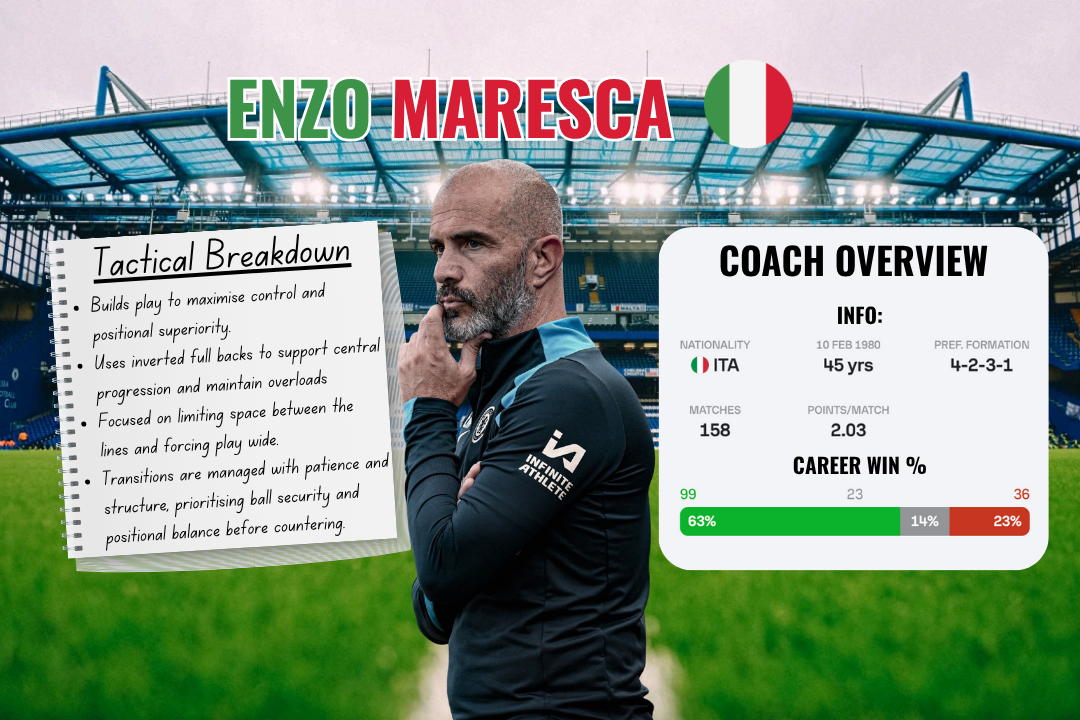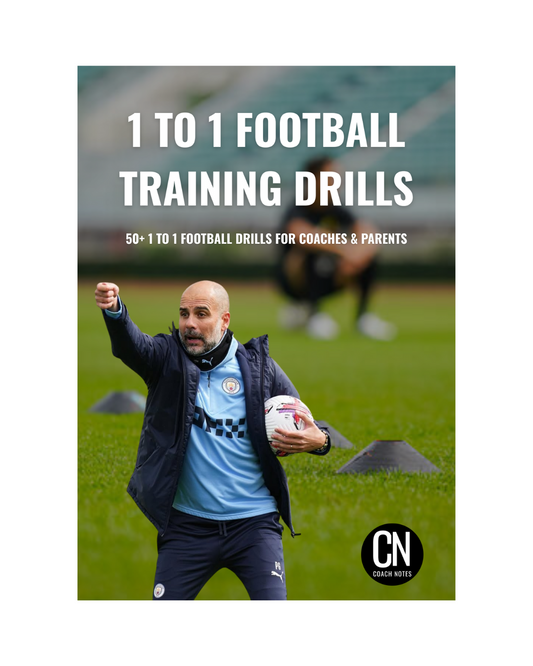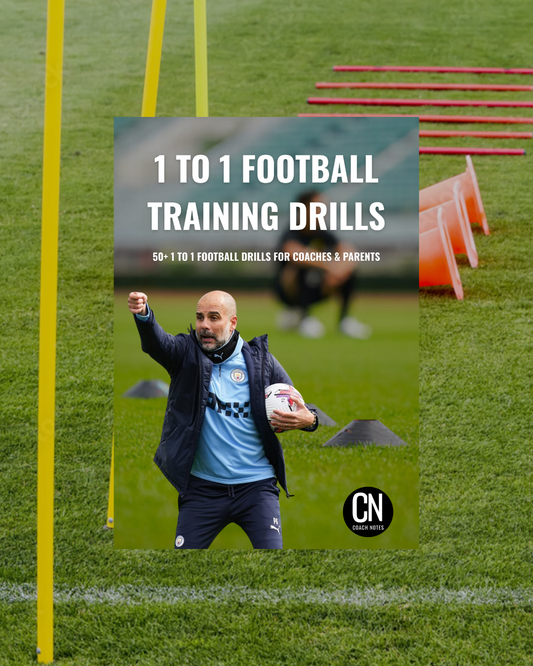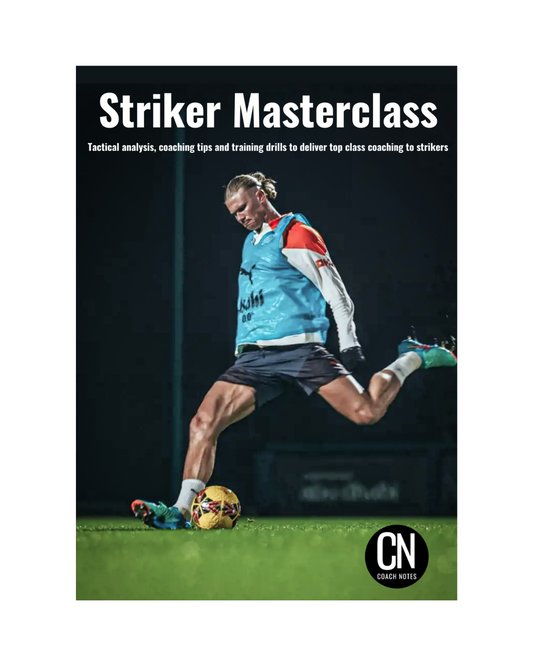
Enzo Maresca
Share
👤 Coach Bio
Enzo Maresca is one of the most intriguing tactical minds of the modern game. A former midfielder who enjoyed a well-travelled playing career across Italy, Spain and England, Maresca transitioned into coaching with a clear ambition to develop his own defined methodology. After learning under Pep Guardiola at Manchester City as part of the backroom staff, he stepped into head coaching roles at Parma, Manchester City U23s, Leicester City and most recently Chelsea.
At Leicester, Maresca led the team to a Championship title by applying a detailed and possession-oriented philosophy, drawing attention for his strict positional demands and structured approach. His appointment at Chelsea represents a bold step, tasking him with imposing a clear tactical identity on a club known for short-termism. Still relatively early in his managerial journey, Maresca is already shaping a reputation for clarity, control and innovation.
⚽ Playing Philosophy
Maresca’s philosophy is founded on positional play, technical security and collective control. Inspired by Guardiola’s model of play, he uses the ball as a defensive and attacking tool prioritising structure, spacing, and numerical superiority across all phases.
His teams seek to dominate the ball in the opponent’s half, patiently progressing through the thirds with purposeful positioning and calm distribution. Every player has a defined role within a set positional framework. Maresca sees rhythm and control as prerequisites to creativity and chance creation. While ball retention is paramount, it is never sterile, the objective is always to disorganise the opposition to create space for incisive movement and final-third entries.
🔍 Style of Play
In Possession
Maresca’s preferred in-possession structure is a 3-2-5, built primarily from a back four where one full-back (often the left) inverts into midfield alongside the pivot, while the other (usually the right) stays wide. The two centre-backs and goalkeeper form the first line of build-up, giving security and access to angles.
- Build-Up Phase: Play starts patiently, often with short combinations between the centre-backs and goalkeeper to draw pressure. The 3-2 base allows for vertical progression through the middle or half-spaces, with third-man combinations and positional rotations unlocking lines.
- Midfield Occupation: The double pivot provides stability and passing options while the attacking five (two wide, three inside) push high to pin back the defensive line.
- Final Third: Attacking midfielders and full-backs rotate into half-spaces to combine, create overloads and support underlaps or cut-backs. Width is often held by wingers, allowing central areas to be manipulated with positional rotations.
Maresca values structure over improvisation. If openings do not appear, his sides often recycle play to reset shape and rebuild the attack.
Out of Possession
Maresca’s sides typically defend in a 4-4-2 or 4-2-3-1 mid-block, though can push higher depending on the game state.
- Defensive Shape: The aim is to block central lanes and funnel play wide. Wingers drop into midfield lines, and the forward line sets pressing traps by shadowing passing options.
- Pressing Triggers: While not a full high-press side, Maresca uses pressing triggers based on opponent movement. Backwards or square passes often initiate a coordinated press from the front three supported by midfielders closing space.
- Compactness: Horizontal and vertical compactness is non-negotiable. Players are drilled to maintain tight distances and restrict gaps, particularly between the lines.
Transitional Moments
- Attacking Transitions: Maresca’s teams do not always counter at pace. Instead, the immediate instinct is to regain shape and build with control. However, if the space is open, vertical passes to inside forwards or wingers are utilised.
- Defensive Transitions: Upon losing the ball, a coordinated counter-press involving 3–5 nearby players seeks to disrupt the opposition’s initial pass. Players are coached to collapse space quickly and either win the ball or delay the counter.
🧠 How to Coach Like Enzo Maresca
Maresca’s training methodology is built on clarity, positional repetition and game-relevant exercises. He is known for intense detail in both on-pitch work and off-pitch preparation.
- Positional Drills: Sessions focus heavily on shape maintenance in possession. Players train within zones, understanding where they should be and why.
- Shadow Play & Rondo Variations: Exercises often include 11v0 walkthroughs to build automatisms, and small rondos to work on quick combinations and spacing.
- Video Analysis: Maresca is meticulous in reviewing match and training footage. Players are expected to understand tactical concepts visually as well as physically.
- Tactical Reset Drills: Training often simulates scenarios where players must lose the ball and immediately reset shape for rest defence or pressing.
For coaches, adopting his model means setting clear tactical rules, embedding structure in all phases, and demanding collective discipline with and without the ball.
👥 Player Profiles
Maresca’s system relies on intelligent, tactically disciplined players who understand spatial dynamics and positional play.
- Centre-Backs: Must be technically secure under pressure and comfortable playing wide in build-up. Passing range and calm decision-making are essential.
- Inverted Full-Backs: Key to the system. Must read the game well, operate in midfield spaces, and support transitions defensively and offensively.
- Midfielders: Dual profiles are valued — one for control and circulation, the other more advanced for linking and progression.
- Attackers: Wingers must stretch the pitch and rotate intelligently, while attacking midfielders need composure and vision between lines. Forwards must link play and finish moves.
🔑 Key Takeaways for Coaches
- Emphasise positional structure: Players must understand their zones, the roles of others, and how to occupy space with intent.
- Control transitions through rest defence: Even when attacking, the team must be positioned to prevent the counter. This means thinking one phase ahead.
- Use clear build-up patterns: Embed a 3-2-5 or 2-3-5 progression model to structure your team’s play through the thirds.
- Value patient possession: Teach players to resist forcing passes. Resetting and recycling are vital tools to maintain rhythm and control.
- Be deliberate with coaching: Use freeze frames, positional drills and tactical walkthroughs to embed ideas. Clarity is more important than complexity.









